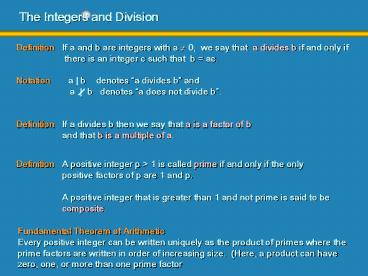The Integers and Division PowerPoint PPT Presentation
1 / 7
Title: The Integers and Division
1
The Integers and Division
Definition If a divides b then we say that a is
a factor of b and that b is a
multiple of a.
Definition A positive integer p gt 1 is called
prime if and only if the only
positive factors of p are 1 and p.
A positive integer that is greater than 1 and
not prime is said to be
composite.
Fundamental Theorem of Arithmetic Every
positive integer can be written uniquely as the
product of primes where the prime factors are
written in order of increasing size. (Here, a
product can have zero, one, or more than one
prime factor
2
The Division Algorithm
- Theorem (The Division Algorithm) Let a be
an integer and d a positive integer. Then
there are unique integers q and r such that
0 ? r lt d and a d?q r - If a , d , q , and r are as in the Division
Algorithm, then d is called the divisor, a is
called the dividend, q is called the quotient
and r is called the remainder - Examples
- 101 11?9 2 and hence the quotient when 101 is
divided by ll is 9 and the remainder is 2 - -11 3?(-4) 1 and hence the quotient when -11
is divided by 3 is -4 and the remainder is 1
3
Greatest Common Divisor
- Definition Let m and n be integers, not both
zero. The largest integer d such that d m
and d n is called the greatest common
divisor of m and n and is denoted by gcd(m ,n
). - Examples
- gcd(24,36) 12
- gcd(17,22) 1
- Definition Integers a and b are relatively
prime if and only if their greatest common
divisor is 1 - From the previous examples, we see that 17
and 22 are relatively prime while 24 and 36 are
not relatively prime.
4
Least Common Multiple
- Definition Let a and b be positive integers.
The least integer d such that a d and b
d is called the least common multiple of a
and b and is denoted by lcm(a ,b ) - Suppose we write positive integers a and b as a
product of primes so that the factorizations use
the same prime factors (some of whom may have
zero exponent) - a p1a1 p2a2 ? ? ? pnan
b p1b1 p2b2 ? ? ? pnbn - Then gcd(a ,b ) p1min(a1,b1) p2min(a2,b2)
? ? ? pnmin(an,bn) - and lcm(a ,b ) p1max(a1,b1) p2max(a2,b2)
? ? ? pnmax(an,bn) - Example 120 23?3?5 and 500 22 ? 53 ,
sogcd(120,500) 2min(3,2)?3min(1,0)?5min(1,3)
22?30?51 4?5 20 - lcm(120,500) 2max(3,2)?3max(1,0)?5max(1,3)
23?31?53 8?3?53
24?125 3000
5
Congruence
Theorem Let a, b, and c be integers . Then for
any integer m gt 0, (i) a ?
a (modulo m) (ii) if a ?
b (modulo m), then b ? a (modulo m)
(iii) if a ? b (modulo m) and b ? c
(modulo m), then a ? c (modulo m).
Theorem Let m be a positive integer. Then the
integers a and b are congruent modulo m
if and only if there is an
integer k such that a b k?m
6
Congruence and Arithmetic Operations
- Theorem Let m be a positive integer. If a ? b
(modulo m ) and c ? d (modulo m ), then a c
? b d (modulo m ) and a ?c ? b ?d (modulo m )
- Proof. Since a ? b (modulo m ) and c ? d
(modulo m ), there are integers s and t with
b a sm and d c tm. - Thus b d a sm c tm (a
c ) (s t )m, - and b?d (a sm )? (c tm )
a ? c (at cs stm)m It now
follows that a c ? b d (modulo m ) and a ?c
? b ?d (modulo m )
7
Modular Arithmetic
- Definition If a is an integer and m is a
positive integer, then we
define a mod m to be the remainder when a is
divided by m. - Examples17 mod 5 2 -133 mod 9 2 2001 mod
101 82 - Fact If a, b, m gt 0 are integers, then
a ? b (modulo m) if and only if a mod m b
mod m.

